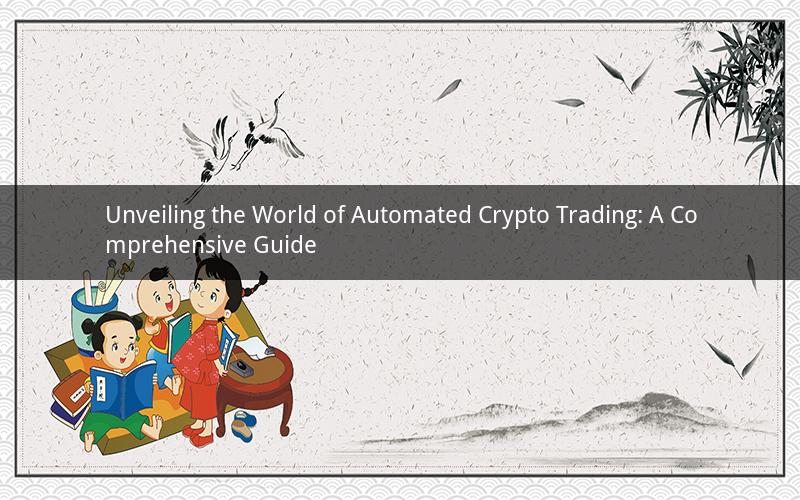
Introduction:
Automated crypto trading has emerged as a revolutionary trend in the cryptocurrency market. It offers traders the opportunity to execute trades with precision and efficiency, leveraging advanced algorithms and technology. In this article, we will delve into the intricacies of automated crypto trading, exploring its benefits, risks, and the key components involved. Additionally, we will address five frequently asked questions to provide a clearer understanding of this fascinating field.
Section 1: Understanding Automated Crypto Trading
1. Definition:
Automated crypto trading refers to the use of computer programs or algorithms to execute trades in the cryptocurrency market. These programs analyze market data, identify trading opportunities, and automatically execute trades based on predefined rules and parameters.
2. How it Works:
Automated crypto trading systems rely on algorithms that analyze vast amounts of data in real-time. These algorithms use historical price patterns, technical indicators, and other metrics to identify potential trading opportunities. Once a profitable opportunity is detected, the system automatically executes the trade on behalf of the trader.
3. Types of Automated Crypto Trading Systems:
a. Algorithmic Trading: This involves using mathematical models and algorithms to identify and execute trades. It is commonly used by professional traders and institutions.
b. High-Frequency Trading (HFT): HFT systems execute trades at extremely high speeds, taking advantage of small price discrepancies in the market.
c. Machine Learning and AI: These systems utilize machine learning algorithms to learn from historical data and make predictions about future market movements.
Section 2: Benefits of Automated Crypto Trading
1. Efficiency and Speed:
Automated crypto trading systems can execute trades at lightning speed, ensuring that traders can capitalize on fleeting market opportunities. This speed is particularly crucial in the fast-paced cryptocurrency market.
2. Emotion-Free Trading:
Humans are prone to emotions, which can lead to impulsive and irrational decision-making. Automated trading eliminates the human element, ensuring that trades are executed based on predefined rules and strategies, leading to more disciplined and consistent trading.
3. 24/7 Trading:
The cryptocurrency market operates 24/7, and automated trading systems can continuously monitor the market and execute trades at any time, even when the trader is unavailable.
4. Risk Management:
Automated trading systems can implement advanced risk management techniques, such as stop-loss orders and position sizing, to minimize potential losses.
Section 3: Risks and Challenges of Automated Crypto Trading
1. Market Volatility:
The cryptocurrency market is known for its high volatility, which can lead to significant gains or losses. Automated trading systems may struggle to navigate these volatile conditions, resulting in unexpected outcomes.
2. System Failures:
Technical failures or malfunctions in automated trading systems can lead to erroneous trades or even complete system breakdowns. Traders must ensure that their systems are robust and reliable.
3. Lack of Human Oversight:
Automated trading systems operate based on predefined rules, which may not always align with the trader's objectives. Without human oversight, there is a risk of the system making trades that deviate from the trader's strategy.
4. Regulatory Challenges:
The cryptocurrency market is still evolving, and regulatory frameworks may vary across different jurisdictions. Traders must be aware of the legal and regulatory implications of automated crypto trading.
Section 4: Key Components of Automated Crypto Trading
1. Trading Platform:
A reliable trading platform is essential for executing trades. It should offer advanced features, real-time market data, and a user-friendly interface.
2. Data Feeds:
Access to accurate and timely market data is crucial for automated trading systems. High-quality data feeds provide the necessary information to make informed trading decisions.
3. Algorithmic Trading Strategy:
Developing a robust and effective trading strategy is essential for successful automated crypto trading. This involves selecting appropriate indicators, setting parameters, and backtesting the strategy.
4. Risk Management Techniques:
Implementing risk management techniques, such as stop-loss orders and position sizing, helps mitigate potential losses and protect the trader's capital.
Section 5: Frequently Asked Questions (FAQs)
1. Q: Can automated crypto trading guarantee profits?
A: No, automated crypto trading does not guarantee profits. While it can enhance efficiency and discipline, it is still subject to market risks and volatility.
2. Q: Do I need technical expertise to use automated crypto trading systems?
A: While technical expertise can be beneficial, many automated trading platforms offer user-friendly interfaces and pre-built strategies for traders of all skill levels.
3. Q: Can I use automated crypto trading for other financial markets?
A: Automated crypto trading systems are primarily designed for the cryptocurrency market. However, some platforms may offer the ability to trade other financial instruments, such as stocks or commodities.
4. Q: How much does automated crypto trading cost?
A: The cost of automated crypto trading can vary depending on the platform and the features offered. Some platforms charge a one-time fee, while others may charge a subscription fee or take a percentage of profits.
5. Q: Can I manually override an automated trading system?
A: Yes, many automated trading systems allow traders to manually override or cancel trades. However, it is important to exercise caution and ensure that manual interventions align with the overall trading strategy.
Conclusion:
Automated crypto trading has revolutionized the way traders approach the cryptocurrency market. By leveraging advanced algorithms and technology, traders can execute trades with precision and efficiency. However, it is crucial to understand the risks and challenges associated with automated trading and to implement robust risk management techniques. With the right knowledge and tools, automated crypto trading can be a valuable addition to any trader's arsenal.